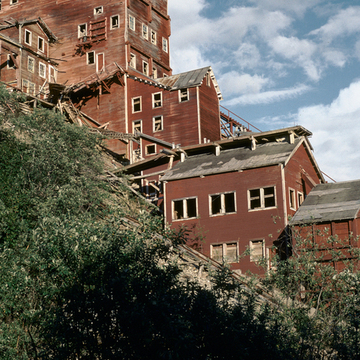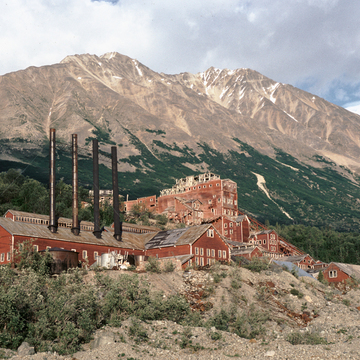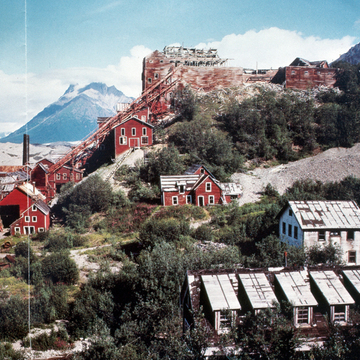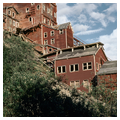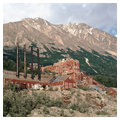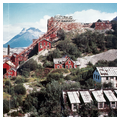One of the largest copper mines in the United States, the Kennecott Mines produced between $200 and $300 million worth of copper between 1910 and 1938. Located in the Wrangell Mountains, most of the buildings survive to illustrate the technology and work environment of this productive mine.
The site was staked in 1900 and soon acquired by Stephen Birch, a young mining engineer. Legal battles ensued and title was not cleared until 1905, when Birch's Alaska Copper and Coal Company was reorganized as the Kennecott Mines Company (a misspelling of the glacier). The Guggenheim family and J. P. Morgan provided the capital for development, investing $25 million before any copper had been produced. The investment included the mine and mill works, the 196-mile Copper River and Northwestern Railway running from the mine to Cordova, and a steamship line to connect the port of Cordova to the Guggenheims' smelter in Tacoma, Washington.
In 1911 the first load of copper, worth $250,000, was shipped. Four years later the
The distinction of the Kennecott mine was not only in its size—it consistently ranked in the top ten of the nation's producers between 1915 and 1922—but also in the quality of the ore. Improvements in refining the ore prior to smelting were immediately implemented at this site to concentrate 2 percent or lower grade ore up to 50 to 80 percent before shipment to the smelter. Ammonia leaching, a process perfected by E. Tappan Stannard in 1915, was first employed on a commercial scale at Kennecott. Leaching involved using chemicals to dissolve the mineral and then precipitate it into a concentrate. Flotation, using oil or grease to separate mineral from ore through a bubbling action, was implemented in 1922–1923, as soon as the patent was cleared. Kennecott's ability to extract higher mineral values from low-grade ores accounted for its overwhelming profitability.
The mine complex is located at the foot of Bonanza Ridge, wedged between the steep mountainside and the moraine of the Kennicott Glacier. Forty-five buildings and about twenty-five outbuildings—all wood-framed, painted red with white trim—remain, all constructed between 1907 and 1925. Using
Much of the work took place, however, up the mountainside, inside the earth. When the mine was abandoned in 1938, there were approximately 70 miles of tunnels in Bonanza Ridge. Ore was brought to the mill via trams. At the mine openings, bunkhouses, mine shops, and tramway stations were constructed; some of these remain. It is at the foot of the ridge, however, that the most impressive collection of buildings stands. Industrial buildings, residential housing, schoolhouses, a dairy barn, hospital, recreation hall, and store illustrate the self-sufficiency of the company town of Kennecott.
Abandoned in 1938, much of the complex fell into ruin over the next half century. It was not until the 1980s that Alaska's burgeoning tourist industry led to renewed interest in Kennecott and the town's designation as a National Historic Landmark. The National Park Service acquired the site in 1998 and has slowly been stabilizing and rehabilitating much of the mill and town buildings. The Kennecott Mines National Historic Landmark is located within the Wrangell-St. Elias National Park and Preserve.

